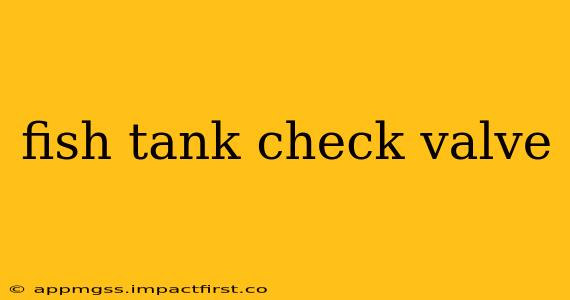Maintaining a healthy aquarium environment relies on many factors, and proper water circulation is paramount. A crucial component often overlooked is the humble check valve. Understanding their function and application within your fish tank setup can significantly improve water quality and overall aquarium health. This guide delves into the world of fish tank check valves, explaining their purpose, types, installation, and troubleshooting.
What is a Check Valve in a Fish Tank?
A check valve, also known as a one-way valve or non-return valve, is a simple yet essential device that allows fluid to flow in only one direction. In the context of a fish tank, this prevents water from flowing backward, protecting sensitive equipment and maintaining consistent water levels. This is especially important for systems employing pumps, filters, or other devices where backflow could disrupt the established water flow or cause damage. They are often small, unobtrusive components, but play a significant role in the overall functionality and longevity of your aquarium setup.
Why Use a Check Valve in Your Aquarium?
The benefits of incorporating check valves into your aquarium system are numerous:
-
Preventing Backflow: This is the primary function. Backflow can occur due to power outages, pump failures, or pressure fluctuations within the system. A check valve prevents this potentially harmful backflow from contaminating clean water sources or damaging equipment.
-
Protecting Equipment: Backflow can introduce air into pumps and filters, causing damage or reducing their effectiveness. Check valves act as a safeguard, protecting your investment in these crucial components.
-
Maintaining Water Levels: In systems with multiple tanks or intricate plumbing, a check valve helps to maintain consistent water levels in each component, preventing undesirable fluctuations.
-
Simplified Maintenance: By preventing backflow, check valves simplify maintenance tasks, as you don't have to worry about draining lines or dealing with water flowing in the wrong direction during repairs or cleaning.
What Types of Check Valves are Used in Aquariums?
Several types of check valves are suitable for aquarium use, each with its own advantages and disadvantages:
-
Ball Check Valves: These are the most common type, featuring a small ball that seals the opening when the flow reverses. They are inexpensive and reliable for most aquarium applications.
-
Swing Check Valves: These utilize a hinged flap or disc that seals the opening against backflow. They are generally more durable than ball check valves but can be slightly more expensive.
-
Diaphragm Check Valves: These utilize a flexible diaphragm to seal the opening. They are often used in applications requiring higher pressure resistance.
How to Install a Check Valve in Your Aquarium System?
Installing a check valve is relatively straightforward. However, it is crucial to ensure proper placement and orientation. Always ensure the arrow on the valve (indicating the direction of flow) is pointing towards the intended flow direction. Use aquarium-safe tubing and clamps to secure the valve in place, preventing leaks. Consult your specific equipment's instructions for details on proper placement.
Where should I install a check valve in my aquarium?
Check valves are typically installed between the pump or filter outlet and the rest of the aquarium plumbing. Their precise location will depend on your specific setup, but the goal is to prevent backflow into the pump or filter.
What size check valve do I need for my aquarium?
The appropriate size of check valve depends on the diameter of your tubing. Make sure to select a valve with an inner diameter that matches your tubing to ensure a proper seal and efficient water flow.
Can I use a check valve with a submersible pump?
Yes, you can use a check valve with a submersible pump, but make sure the valve is compatible with the pump's flow rate and that the valve is appropriately sealed to prevent water leakage.
Troubleshooting Check Valve Issues
-
No Flow: Ensure the valve is correctly installed with the arrow pointing in the correct direction. Check for obstructions within the valve or tubing.
-
Leaking: Check the seals and ensure a tight connection between the valve and tubing. Replace the valve if the leak persists.
Conclusion
While often small and overlooked, check valves play a critical role in maintaining a healthy and stable aquarium environment. By understanding their function, selecting the appropriate type, and ensuring proper installation, you can protect your investment and safeguard the well-being of your aquatic life. Remember to always consult your equipment's manual for specific instructions and recommendations.
